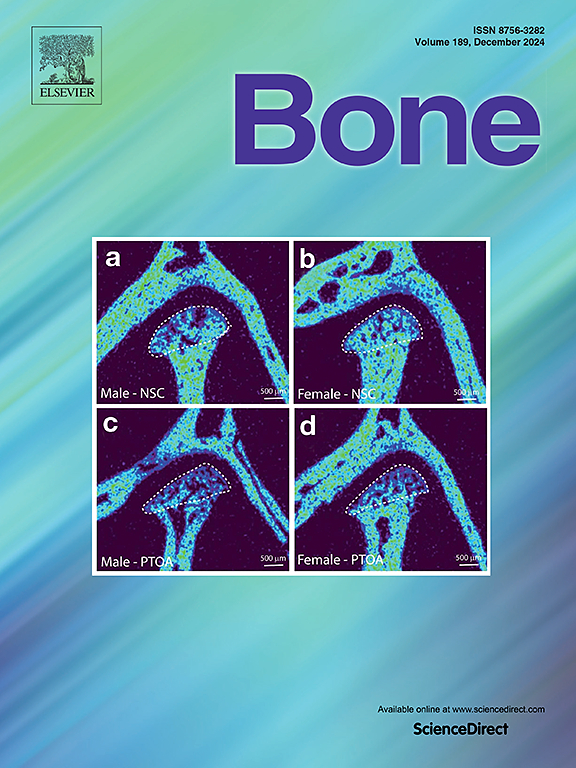与成骨不全症相关的临床和医疗负担的现实世界分析。
IF 3.6
2区 医学
Q2 ENDOCRINOLOGY & METABOLISM
引用次数: 0
摘要
在美国临床实践中,成骨不全症(OI)的医疗资源利用率(HCRU)和成本负担目前尚不清楚。方法:这项现实世界的回顾性研究使用Optum的去识别Clinformatics®数据集市数据库(2015年10月1日至2023年11月30日)评估了≥1例住院索赔或 ≥ 2例门诊索赔的OI ICD-10代码患者。患者需要连续参加≥24 个月的医疗保健计划;索引日期为OI诊断代码的首次索赔。在年龄、性别、索引日期和随访时间方面,成骨不全患者与非成骨不全患者1:5匹配。合并症、骨折、HCRU和人均年费用(PPY)按年龄分层(≤19 岁,20-54 岁,≥55 岁)。连续变量和分类变量分别采用t检验和卡方检验进行比较。建立了HCRU和成本的广义线性和逻辑回归模型。结果:总体而言,1367例成骨不全患者(≤19 年,n = 324;20-54 年,n = 521;≥55 年,n = 522)与6835名非成骨不全对照者匹配。与对照组相比,HCRU在成骨不全患者中更常见;PPY住院率分别为0.17对0.05(≤19 年)、0.20对0.11(20-54 年)、0.32对0.15(≥55 年)(p )。结论:在美国临床实践中,观察到成骨不全患者存在巨大的临床和经济负担。这些发现可能为疾病改善疗法的评估提供信息。本文章由计算机程序翻译,如有差异,请以英文原文为准。
A real-world analysis of the clinical and healthcare burden associated with osteogenesis imperfecta
Introduction
The healthcare resource utilization (HCRU) and cost burden of osteogenesis imperfecta (OI) in US clinical practice is currently unclear.
Methods
This real-world, retrospective study assessed patients with ≥1 inpatient claim or ≥ 2 outpatient claims with ICD-10 codes for OI using Optum's deidentified Clinformatics® Data Mart Database (Oct 1, 2015–Nov 30, 2023). Patients were required to have ≥24 months' continuous healthcare plan enrollment; index date was first claim with OI diagnosis code. Patients with OI were matched 1:5 with non-OI patients on age, sex, index date, and follow-up duration. Comorbidities, fractures, HCRU, and costs per person-year (PPY) were stratified by age (≤19 years, 20–54 years, ≥55 years). Continuous and categorical variables were compared using t-tests and chi-square tests, respectively. Generalized linear and logistic regression models were constructed for HCRU and costs.
Results
Overall, 1367 patients with OI (≤19 years, n = 324; 20–54 years, n = 521; ≥55 years, n = 522) were matched with 6835 non-OI controls. HCRU was more frequent in patients with OI versus controls; PPY inpatient admissions were 0.17 versus 0.05 (≤19 years), 0.20 versus 0.11 (20–54 years), and 0.32 versus 0.15 (≥55 years) (p < 0.01). OI patients had higher total healthcare costs than non-OI controls (≤19 years, $26,892 vs $10,134; 20–54 years, $27,673 vs $16,101; ≥55 years, $42,335 vs $25,143 PPY) (p < 0.01), driven by increased outpatient visits (pediatrics) and inpatient admissions (adults).
Conclusion
Substantial clinical and economic burden was observed in patients with OI in US clinical practice. These findings may inform evaluation of disease-modifying therapies.
求助全文
通过发布文献求助,成功后即可免费获取论文全文。
去求助
来源期刊

Bone
医学-内分泌学与代谢
CiteScore
8.90
自引率
4.90%
发文量
264
审稿时长
30 days
期刊介绍:
BONE is an interdisciplinary forum for the rapid publication of original articles and reviews on basic, translational, and clinical aspects of bone and mineral metabolism. The Journal also encourages submissions related to interactions of bone with other organ systems, including cartilage, endocrine, muscle, fat, neural, vascular, gastrointestinal, hematopoietic, and immune systems. Particular attention is placed on the application of experimental studies to clinical practice.
 求助内容:
求助内容: 应助结果提醒方式:
应助结果提醒方式:


